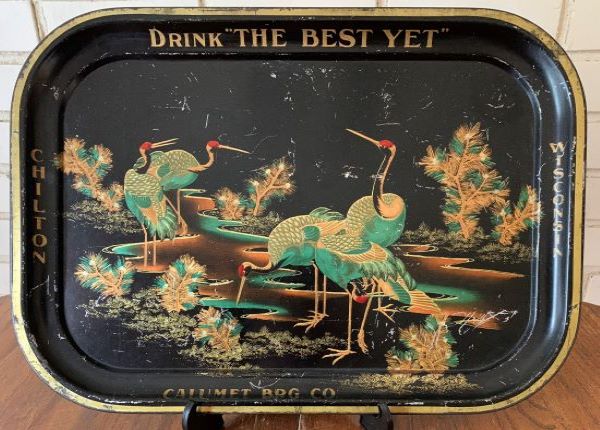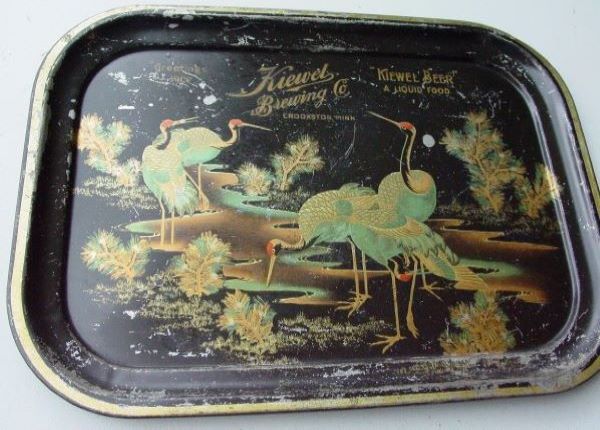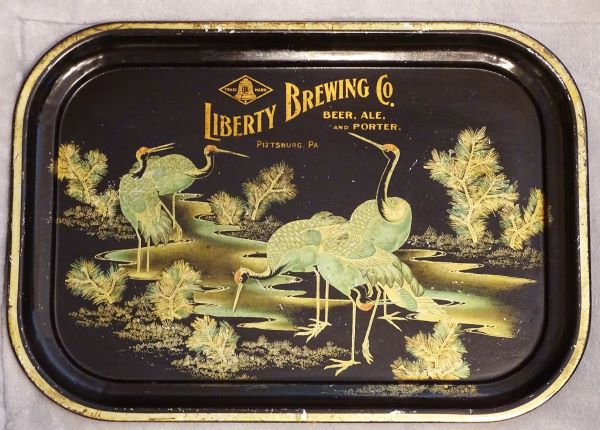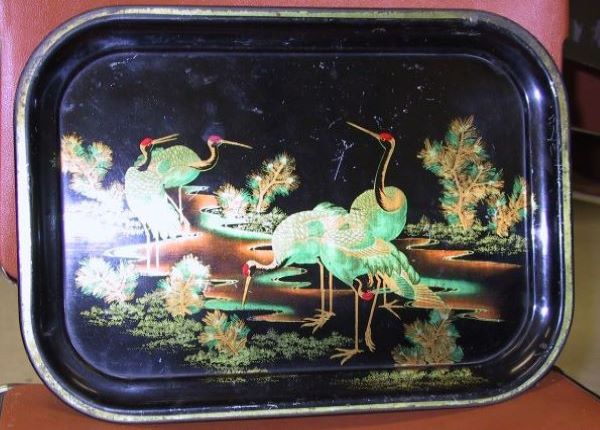The 'Stock' Exchange
The Meek Co.: No. 59 "Japanese Storks"
The Meek Co.: No. 59 "Japanese Storks"
Date: 1905 - 1907
Size: 17.25" x 12.25"
Type: Plate
Scarcity: Scarce
Value: $$$ to $$$$
Condition & Brewer Dependent
Size: 17.25" x 12.25"
Type: Plate
Scarcity: Scarce
Value: $$$ to $$$$
Condition & Brewer Dependent
General
No. 59 represents a significant departure artistically from all of the designs that had come before, all of which reflect western artistic ideals and characteristics of the late 19th and early 20th century. No. 59 imitates Japanese lacquerware, an ancient decorative craft used on a wide variety of objects from statutes to food boxes involving metal powder sprinkled on lacquer from the lacquer tree. Lacquer was used as early as 7000 BC and early surviving examples are mostly pottery or wood. Traditionally lacquerware is black with metallic designs; colored lacquer was introduced in the 18th century.
In Western countries this type of decorative finishing is frequently referred to as “Japanning” to differentiate that it is not technically lacquering since true lacquer sap was unavailable. It was initially used to decorate furniture but later was used on smaller metal items. Japanning technique was known and practiced in Europe from the 17th century and certainly would have been familiar to the transplanted Europe artisans Meek employed. Strangely, japanning was fading away as a decorative technique by the time this design was produced and was being replace by other approaches such as electroplating. It is claimed that in America Japanning evolved (devolved?) into what we current refer to as toleware.
Sahling has an entry in his workbook for “Japanese oblong stock tray” in June of 1905. Although he’d previously done “A Close Game” (No. 46) this design seems to mark the beginning of more frequent assignment to developing stock designs.
Shape & Rim & Ad Text
All known tray examples have been landscape oriented, large oblongs. These are relatively flat with a broad edge reminiscent of Tuscarora trays. Up to this point the few times Tuscarora/M&B/Meek had used large oblongs they had be portrait oriented. Advertising text usually shows up in gold print on the face of the tray, but also shows up on the back of the tray. We don’t recall an example printed on the rim. Examples that we’ve seen in person all have carried the Meek logo.
Hager & Price
Hager includes this design in his catalog, but it isn’t discussed in his article. For some reason this design didn’t wear well—perhaps because it required far fewer printings than other trays to achieve the final image. In any case, most examples we’ve seen have in only fair to good condition. As a result, prices for both brewers and non-brewers have been on the lower end despite being a comparatively rare design. Of the few brewery examples, the Calumet Brewing from Chilton, WI shows up most frequently.
No. 59 represents a significant departure artistically from all of the designs that had come before, all of which reflect western artistic ideals and characteristics of the late 19th and early 20th century. No. 59 imitates Japanese lacquerware, an ancient decorative craft used on a wide variety of objects from statutes to food boxes involving metal powder sprinkled on lacquer from the lacquer tree. Lacquer was used as early as 7000 BC and early surviving examples are mostly pottery or wood. Traditionally lacquerware is black with metallic designs; colored lacquer was introduced in the 18th century.
In Western countries this type of decorative finishing is frequently referred to as “Japanning” to differentiate that it is not technically lacquering since true lacquer sap was unavailable. It was initially used to decorate furniture but later was used on smaller metal items. Japanning technique was known and practiced in Europe from the 17th century and certainly would have been familiar to the transplanted Europe artisans Meek employed. Strangely, japanning was fading away as a decorative technique by the time this design was produced and was being replace by other approaches such as electroplating. It is claimed that in America Japanning evolved (devolved?) into what we current refer to as toleware.
Sahling has an entry in his workbook for “Japanese oblong stock tray” in June of 1905. Although he’d previously done “A Close Game” (No. 46) this design seems to mark the beginning of more frequent assignment to developing stock designs.
Shape & Rim & Ad Text
All known tray examples have been landscape oriented, large oblongs. These are relatively flat with a broad edge reminiscent of Tuscarora trays. Up to this point the few times Tuscarora/M&B/Meek had used large oblongs they had be portrait oriented. Advertising text usually shows up in gold print on the face of the tray, but also shows up on the back of the tray. We don’t recall an example printed on the rim. Examples that we’ve seen in person all have carried the Meek logo.
Hager & Price
Hager includes this design in his catalog, but it isn’t discussed in his article. For some reason this design didn’t wear well—perhaps because it required far fewer printings than other trays to achieve the final image. In any case, most examples we’ve seen have in only fair to good condition. As a result, prices for both brewers and non-brewers have been on the lower end despite being a comparatively rare design. Of the few brewery examples, the Calumet Brewing from Chilton, WI shows up most frequently.


Confirmed Brewer used Stock Trays
Non-Beer Related & Non-Tray Uses
Click the Picture to Return to Meek & Beach Stock Catalog Page






















